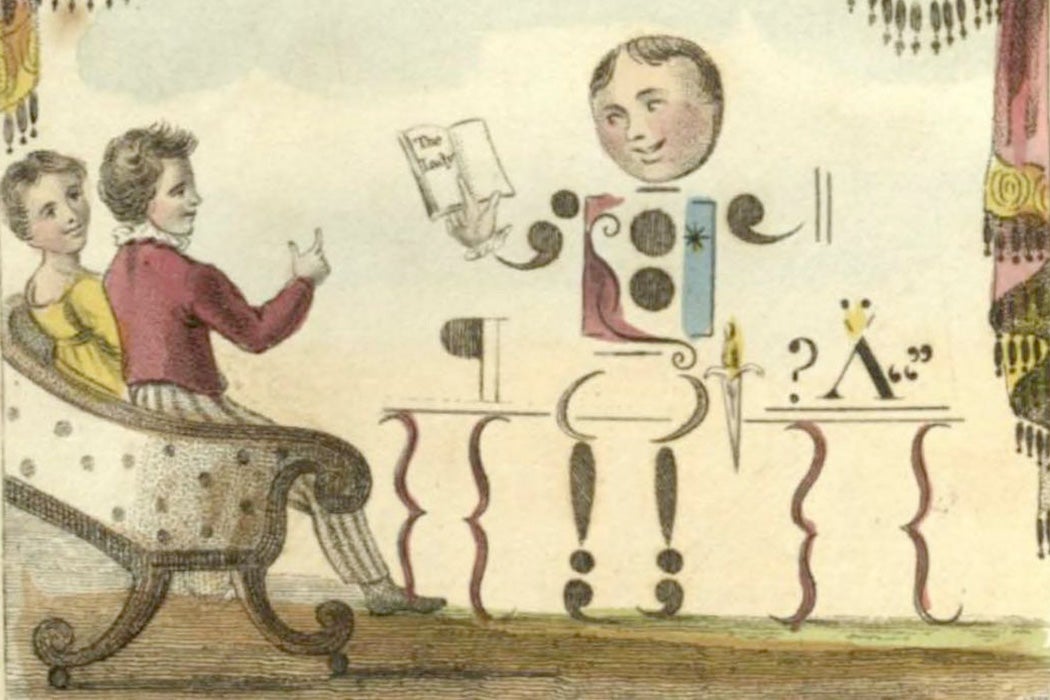In elementary school, we learn that there are logical rules for the use of punctuation. Semicolons connect two related independent clauses, while colons follow an independent clause and introduce a further explanation. But, as English literature and cultural history scholar Neil Rhodes writes, this sort of logical approach to punctuation is only a few centuries old. Prior to that, punctuation was largely a guide to reading aloud.
In classical Greece and Rome, Rhodes writes, “comma,” “colon,” and “period” referred not to marks on paper but to units of language, with “period” roughly corresponding to the modern sentence and the other two terms referring to less complete groupings of words. Aristotle approvingly described speaking “in periods.” In contrast to the “extended” style of breathlessly talking without a pause, he argued, the periodic “contracted” style was more pleasant to listen to and easier to memorize.
Since writing in classical and medieval Europe was normally intended to be read aloud, people used marks to indicate when to pause, and for how long, much the way musical notation indicates rests. In the late medieval era, writers used the term “pointing” or sometimes the Latin “punctuacio” to refer to marks indicating various sorts of pauses.
In the sixteenth century, Rhodes writes, writers still used the same three terms from antiquity—commas, colons, and periods—to indicate the length of a pause. In this era, colons were far more common than they are today, and they were used in a different way. They represented a middle-length pause and were typically used between two halves of a sentence, as in “Tho the daie be long: yet at the last commeth euensong.”
But, gradually, colons and other marks—which eventually became known as “punctuation”—became used less to direct a reader speaking the words aloud and more to convey meaning. These usages often overlapped. Playwright Ben Jonson, for example, covered his scripts with marks intended to convey both speaking patterns and logic. But, Rhodes writes, this resulted in texts “so densely punctuated that they could not possibly be used as a guide to performance. To do so would make all the characters sound asthmatic.” The real purpose, he suggests, was to “make visible the construction of sentences on the page.”
Weekly Newsletter
With the shifting use of punctuation came the rise of the semicolon. These are a much newer kind of punctuation than the colon. They first appeared in print in the 1490s in Venice and didn’t make it into English until around 1580. While they often served much the same purpose as a colon—and might be chosen simply to make a piece of writing look fancier—they were more likely to appear in argumentation than in more literary writing, reflecting their role as a harbinger of the modern and (at least theoretically) rational rules for writing.
“The appearance of this alternative to the colon initiates a long process of transition toward a different and more logical understanding of the function of punctuation,” Rhodes writes.
Teaching Tips:
- “Punctuation,” The Connecticut Common School Journal and Annals of Education (1856)
- “The Importance of Punctuation and the Best Method for Teaching It,” The Connecticut Common School Journal and Annals of Education (1856)
- “Punctuation,” The Connecticut School Journal (1872)
- “Punctuation,” National Journal of Education (1878)
- “Punctuation,” Educational Weekly (1885)
- “On Punctuation and Things of that Sort,” The Irish Monthly (1894)
- “More Notes on Punctuation,” The Irish Monthly (1895)







